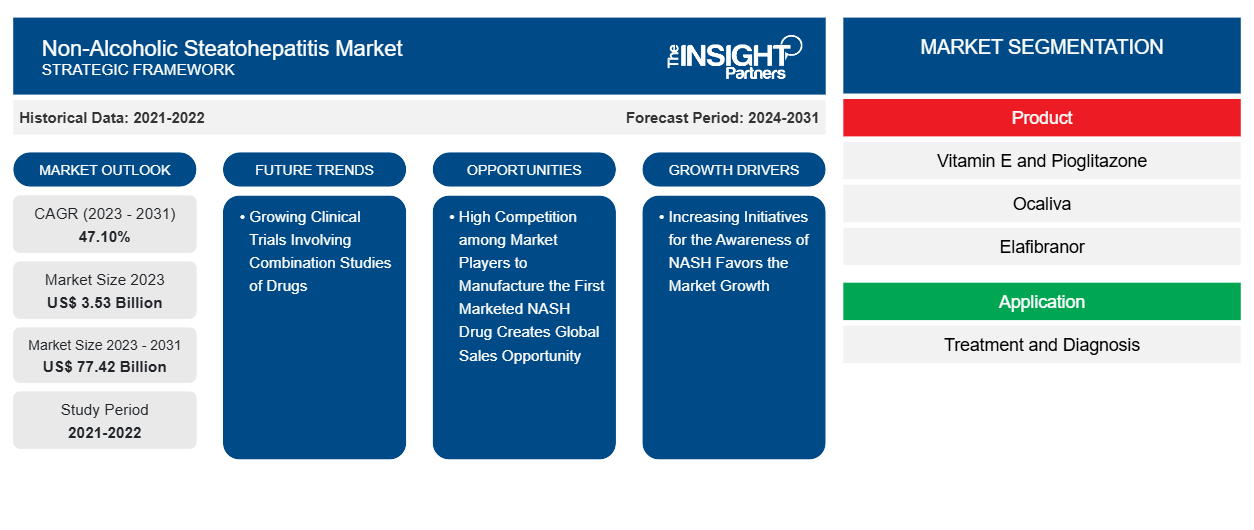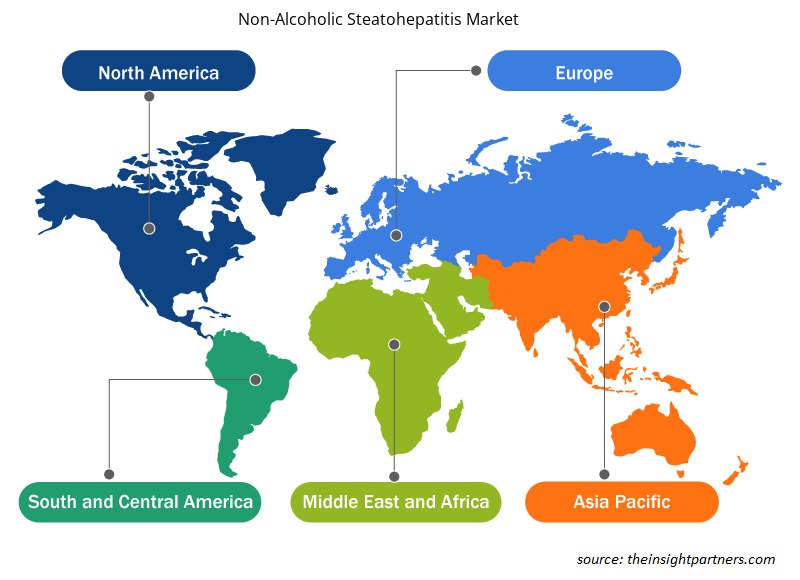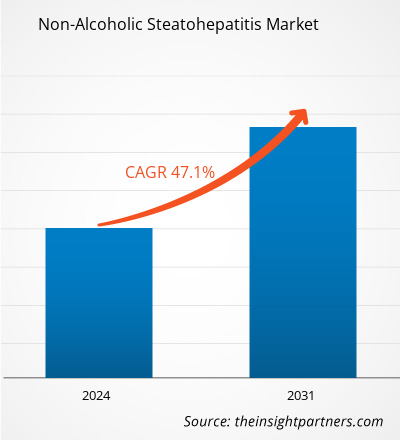The non-alcoholic steatohepatitis market size is projected to reach US$ 77.42 billion by 2031 from US$ 3.53 billion in 2023. The market is expected to register a CAGR of 47.10% during 2023–2031. Growing clinical trials involving combination studies of drugs will likely remain a key trend in the market.
Non-Alcoholic Steatohepatitis Market Analysis
The rising incidence of NASH disorders is expected to propel the market for NASH treatments to more significant growth. The main factors driving the market's growth are the biotechnology industry's expansion and rising R&D spending in the area. Shortly, there will be plenty of lucrative opportunities due to the increasing adoption of NASH diagnosis, with Asia Pacific predicted to grow at the fastest rate. Several initiatives, both inorganic and organic, have been implemented by the businesses to support its expansion. Companies have been using various organic strategies to expand their businesses, such as product launches. The enterprises have used inorganic tactics like partnerships, mergers, and acquisitions. For example, Intercept Pharmaceuticals, Inc. announced in July 2021 that several abstracts on the use of obeticholic acid (OCA) to treat primary biliary cholangitis (PBC) and non-alcoholic steatohepatitis (NASH) will be presented at the 56th Annual Meeting of the European Association for the Study of the Liver (EASL), which will take place virtually from June 23 to June 26, 2021.
Non-Alcoholic Steatohepatitis Market Overview
The potentially deadly condition known as non-alcoholic steatohepatitis (NASH) results in severe liver cirrhosis and scarring. The most prevalent chronic liver disease worldwide is non-alcoholic fatty liver disease (NAFLD). A progressive type of NAFLD known as NASH is increasingly taking the lead in end-stage liver diseases and liver transplantation. The Global Liver Institute released data on June 12, 2019, which indicates that non-alcoholic steatohepatitis (NASH) is considered an epidemic. Moreover, it is a kind of non-alcoholic fatty liver disease (NAFLD) that progresses over time, affecting approximately 115 million individuals currently, with an estimated 357 million by 2030. Significant risk factors for NAFLD and NASH include obesity, type 2 diabetes, and hyperlipidemia; over 70% of the population is obese, 75% has type 2 diabetes, and 20–80% has hyperlipidemia. If NASH is not treated, it can lead to liver cancer, cirrhosis, and the requirement for a liver transplant.
NAFLD/NASH is becoming more common, but it is still an underdiagnosed condition, and preventing its progression and the consequences that go along with it requires early detection. Therefore, it is anticipated that the rising prevalence of NASH will drive the non-alcoholic steatohepatitis (NASH) market.
Customize This Report To Suit Your Requirement
You will get customization on any report - free of charge - including parts of this report, or country-level analysis, Excel Data pack, as well as avail great offers and discounts for start-ups & universities
Non-Alcoholic Steatohepatitis Market: Strategic Insights

- Get Top Key Market Trends of this report.This FREE sample will include data analysis, ranging from market trends to estimates and forecasts.
You will get customization on any report - free of charge - including parts of this report, or country-level analysis, Excel Data pack, as well as avail great offers and discounts for start-ups & universities
Non-Alcoholic Steatohepatitis Market: Strategic Insights

- Get Top Key Market Trends of this report.This FREE sample will include data analysis, ranging from market trends to estimates and forecasts.
Non-Alcoholic Steatohepatitis Market Drivers and Opportunities
Increasing Initiatives for the Awareness of NASH Favors the Market Growth
NASH is a disease that is not well understood. A systematic referral pathway and early detection of this disease depend on raising public and primary care physician (PCP) awareness of it. The patient pool can be increased by identifying more people and sending them to specialists for additional evaluation by creating a clear patient pathway for referrals and patient awareness campaigns. On June 12, 2018, "International NASH Day," the NASH Education Program launched a public education campaign to increase public knowledge of non-alcoholic fatty liver disease (NAFLD), which affects over 115 million people, and its more advanced form, NASH.
On June 12, 2019, International NASH Day, NASH 24X7, a digital platform dedicated to increasing exposure and awareness regarding the NASH epidemic, took a few actions, including HCP support patient awareness. NASH Crusaders of NASH 24X7 teamed up with leading HCPs (gastroenterologists and hepatologists) throughout India to spread awareness on International NASH Day. Regarding patient education, the NASH Crusaders of NASH 24X7 worked with healthcare professionals all over India to organize numerous small- and large-scale awareness- and education-raising workshops on liver health and the importance of leading a healthy lifestyle to prevent NAFLD/NASH. Several initiatives were launched to reach the general public on International NASH Day, including press releases and television programs that used print and digital media.
For International NASH Day on June 12, 2020, the American Liver Foundation joined a global community to raise awareness about NASH with support from the Allergan Foundation. American Liver Foundation (ALF) is now piloting a NASH Text Messaging Program, wherein people can sign up to receive three weekly messages for ten weeks. Messages include hyperlinks to NASH resources, facts, interactive quizzes, and sensible pointers for everyday self-management. ALF will open this system to the general public when the pilot is finished and evaluated. It collaborated with the Global Liver Institute (GLI) for International NASH Day and shared a few social media posts with links to GLI posts and the International NASH Day page.
Thus, rising initiatives for the awareness of NASH are driving the non-alcoholic steatohepatitis (NASH) market.
High Competition among Market Players to Manufacture the First Marketed NASH Drug Creates Global Sales Opportunity
According to Back Bay Life Science Advisors, at its peak, the global NASH market is anticipated to hit an average of USD 13 billion yearly by 2030. As of June 2020, the NASH pipeline of first-wave drugs holds 54 medical candidates in development by 47 companies evaluating 29 unique mechanisms of action. Over the last decades, the NASH pipeline witnessed many late-degree programs fail to reveal clinical efficacy after focusing on a broad range of mechanisms of action. Competition to manufacture the first marketed NASH drug stays high among market players, with numerous late-stage candidates vying for opportunities to launch the first marketed NASH drug. Below are a few companies in drug development's 3rd and 2nd phases. Market players are racing to be the first ones to launch drugs in the market, creating a more significant opportunity to generate sales in the global market.
Non-Alcoholic Steatohepatitis Market Report Segmentation Analysis
Key segments that contributed to the derivation of the non-alcoholic steatohepatitis market analysis are product, application, and sales channel.
- Based on product, the non-alcoholic steatohepatitis market is segmented into vitamin E and pioglitazone, elafibranor, ocaliva, selonsertib & cenicriviroc, and others. The other segment held the most significant market share in 2023.
- By application, the market is divided into treatment and diagnosis. The treatment segment held the largest share of the market in 2023.
- By sales channel, the market is segmented into hospital pharmacy, online provider, and retail pharmacy. The retail pharmacy segment held the largest share of the market in 2023.
Non-Alcoholic Steatohepatitis Market Share Analysis by Geography
The geographic scope of the non-alcoholic steatohepatitis market report is mainly divided into five regions: North America, Asia Pacific, Europe, Middle East & Africa, and South & Central America.
North America consists of three countries: the US, Canada, and Mexico. The US is the largest market for non-alcoholic steatohepatitis, followed by Canada and Mexico. The non-alcoholic steatohepatitis market is expected to grow at a faster rate due to rising research and development activities and increased adoption of technological advancements. Large healthcare organizations and the rising prevalence of non-alcoholic steatohepatitis also fuel the market's growth in this area. Overweight fat accumulates in the liver in a condition known as non-alcoholic fatty liver disease (NAFLD). Heavy alcohol use is not the cause of this fat accumulation. Alcohol-associated liver disease is the term for a condition where the accumulation of fat in the liver is brought on by heavy alcohol consumption. Non-alcoholic fatty liver (NAFL) and non-alcoholic steatohepatitis (NASH) are the two forms of NAFLD. In the US, NAFLD is one of the most frequent causes of liver disease. NAFL is present in most NAFLD patients. NASH is only present in a tiny percentage of NAFLD patients. According to experts, 1.5% to 6.5% of American adults have NASH, and roughly 24% of adult Americans have NAFLD.
NASH is characterized by fat accumulation, inflammation, and cellular damage; it can also lead to cirrhosis and hepatocellular carcinoma. According to a US prevalence study, in 2016 there were 17.3 million NASH cases and 85.3 million NAFLD cases in the US. Due to these conditions, the nation's healthcare expenses are incurred in billions of dollars. Furthermore, NAFLD is a risk factor for cardiovascular disease on its own. As a result, NAFLD and NASH are becoming increasingly essential disease states for payers to oversee.
Non-Alcoholic Steatohepatitis Market Regional Insights
The regional trends and factors influencing the Non-Alcoholic Steatohepatitis Market throughout the forecast period have been thoroughly explained by the analysts at Insight Partners. This section also discusses Non-Alcoholic Steatohepatitis Market segments and geography across North America, Europe, Asia Pacific, Middle East and Africa, and South and Central America.

- Get the Regional Specific Data for Non-Alcoholic Steatohepatitis Market
Non-Alcoholic Steatohepatitis Market Report Scope
| Report Attribute | Details |
|---|---|
| Market size in 2023 | US$ 3.53 Billion |
| Market Size by 2031 | US$ 77.42 Billion |
| Global CAGR (2023 - 2031) | 47.10% |
| Historical Data | 2021-2022 |
| Forecast period | 2024-2031 |
| Segments Covered |
By Product
|
| Regions and Countries Covered | North America
|
| Market leaders and key company profiles |
Non-Alcoholic Steatohepatitis Market Players Density: Understanding Its Impact on Business Dynamics
The Non-Alcoholic Steatohepatitis Market is growing rapidly, driven by increasing end-user demand due to factors such as evolving consumer preferences, technological advancements, and greater awareness of the product's benefits. As demand rises, businesses are expanding their offerings, innovating to meet consumer needs, and capitalizing on emerging trends, which further fuels market growth.
Market players density refers to the distribution of firms or companies operating within a particular market or industry. It indicates how many competitors (market players) are present in a given market space relative to its size or total market value.
Major Companies operating in the Non-Alcoholic Steatohepatitis Market are:
- Genfit SA
- One Way Liver, S.L.
- BioPredictive S.A.S.
- Cadila Pharmaceuticals Ltd.
- Prometheus Laboratories
- Siemens Healthineers AG
Disclaimer: The companies listed above are not ranked in any particular order.

- Get the Non-Alcoholic Steatohepatitis Market top key players overview
Non-Alcoholic Steatohepatitis Market News and Recent Developments
The non-alcoholic steatohepatitis market is evaluated by gathering qualitative and quantitative data post primary and secondary research, which includes important corporate publications, association data, and databases. A few of the developments in the non-alcoholic steatohepatitis market are listed below:
- Novartis announced that it had signed an agreement with Carisma Therapeutic to manufacture the HER 2 targeted CAR-M cell therapy, tested in initial trials to treat solid tumors. (Source: Novartis AG, Press Release, March 2022)
- Siemens Healthineers announced the launch of the Enhanced Liver Fibrosis (ELF) Test in US. This is the first time the test is commercially available in the U.S., following De Novo marketing authorization from the U.S. Food and Drug Administration (FDA) in August 2021. (Source: Siemens Healthineers AG, Press Release, January 2022)
Non-Alcoholic Steatohepatitis Market Report Coverage and Deliverables
The “Non-Alcoholic Steatohepatitis Market Size and Forecast (2021–2031)” report provides a detailed analysis of the market covering below areas:
- Non-alcoholic steatohepatitis market size and forecast at global, regional, and country levels for all the key market segments covered under the scope
- Non-alcoholic steatohepatitis market trends as well as market dynamics such as drivers, restraints, and key opportunities
- Detailed PEST/Porter’s Five Forces and SWOT analysis
- Non-alcoholic steatohepatitis market analysis covering key market trends, global and regional framework, major players, regulations, and recent market developments.
- Industry landscape and competition analysis covering market concentration, heat map analysis, prominent players, and recent developments for the non-alcoholic steatohepatitis market
- Detailed company profiles
Frequently Asked Questions
What is the expected CAGR of the non-alcoholic steatohepatitis market?
The market is expected to register a CAGR of 47.1% during 2023–2031.
Which are the leading players operating in the non-alcoholic steatohepatitis market?
Genfit SA, Cadila Pharmaceuticals Ltd., One Way Liver, S.L., BioPredictive S.A.S., Siemens Healthineers AG, Intercept Pharmaceuticals, Inc., Prometheus Laboratories, Novartis AG, Galmed Pharmaceuticals, Laboratory Corporation of America Holdings
What are the driving factors impacting the non-alcoholic steatohepatitis market?
Key factors driving the market are the Rising Prevalence of NASH and Increasing Initiatives for the Awareness of NASH.
What are the future trends of the non-alcoholic steatohepatitis market?
Growing clinical trials involving combination studies of drugs will likely remain a key trend in the market.
Which region dominated the non-alcoholic steatohepatitis market in 2023?
North America dominated the non-alcoholic steatohepatitis market in 2023
- Historical Analysis (2 Years), Base Year, Forecast (7 Years) with CAGR
- PEST and SWOT Analysis
- Market Size Value / Volume - Global, Regional, Country
- Industry and Competitive Landscape
- Excel Dataset
Testimonials
I wish to appreciate your support and the professionalism you displayed in the course of attending to my request for information regarding to infectious disease IVD market in Nigeria. I appreciate your patience, your guidance, and the fact that you were willing to offer a discount, which eventually made it possible for us to close a deal. I look forward to engaging The Insight Partners in the future, all thanks to the impression you have created in me as a result of this first encounter.
DR CHIJIOKE ONYIA, MANAGING DIRECTOR, PineCrest Healthcare Ltd.The Insight Partners delivered insightful, well-structured market research with strong domain expertise. Their team was professional and responsive throughout. The user-friendly website made accessing industry reports seamless. We highly recommend them for reliable, high-quality research services
Yukihiko Adachi CEO, Deep Blue, LLC.Reason to Buy
- Informed Decision-Making
- Understanding Market Dynamics
- Competitive Analysis
- Customer Insights
- Market Forecasts
- Risk Mitigation
- Strategic Planning
- Investment Justification
- Identifying Emerging Markets
- Enhancing Marketing Strategies
- Boosting Operational Efficiency
- Tracking Industry Innovations
- Aligning with Regulatory Trends
Yes! We provide a free sample of the report, which includes Report Scope (Table of Contents), report structure, and selected insights to help you assess the value of the full report. Please click on the "Download Sample" button or contact us to receive your copy.
Absolutely — analyst assistance is part of the package. You can connect with our analyst post-purchase to clarify report insights, methodology or discuss how the findings apply to your business needs.
Once your order is successfully placed, you will receive a confirmation email along with your invoice.
• For published reports: You’ll receive access to the report within 4–6 working hours via a secured email sent to your email.
• For upcoming reports: Your order will be recorded as a pre-booking. Our team will share the estimated release date and keep you informed of any updates. As soon as the report is published, it will be delivered to your registered email.
We offer customization options to align the report with your specific objectives. Whether you need deeper insights into a particular region, industry segment, competitor analysis, or data cut, our research team can tailor the report accordingly. Please share your requirements with us, and we’ll be happy to provide a customized proposal or scope.
The report is available in either PDF format or as an Excel dataset, depending on the license you choose.
The PDF version provides the full analysis and visuals in a ready-to-read format. The Excel dataset includes all underlying data tables for easy manipulation and further analysis.
Please review the license options at checkout or contact us to confirm which formats are included with your purchase.
Our payment process is fully secure and PCI-DSS compliant.
We use trusted and encrypted payment gateways to ensure that all transactions are protected with industry-standard SSL encryption. Your payment details are never stored on our servers and are handled securely by certified third-party processors.
You can make your purchase with confidence, knowing your personal and financial information is safe with us.
Yes, we do offer special pricing for bulk purchases.
If you're interested in purchasing multiple reports, we’re happy to provide a customized bundle offer or volume-based discount tailored to your needs. Please contact our sales team with the list of reports you’re considering, and we’ll share a personalized quote.
Yes, absolutely.
Our team is available to help you make an informed decision. Whether you have questions about the report’s scope, methodology, customization options, or which license suits you best, we’re here to assist. Please reach out to us at sales@theinsightpartners.com, and one of our representatives will get in touch promptly.
Yes, a billing invoice will be automatically generated and sent to your registered email upon successful completion of your purchase.
If you need the invoice in a specific format or require additional details (such as company name, GST, or VAT information), feel free to contact us, and we’ll be happy to assist.
Yes, certainly.
If you encounter any difficulties accessing or receiving your report, our support team is ready to assist you. Simply reach out to us via email or live chat with your order information, and we’ll ensure the issue is resolved quickly so you can access your report without interruption.





















 Get Free Sample For
Get Free Sample For